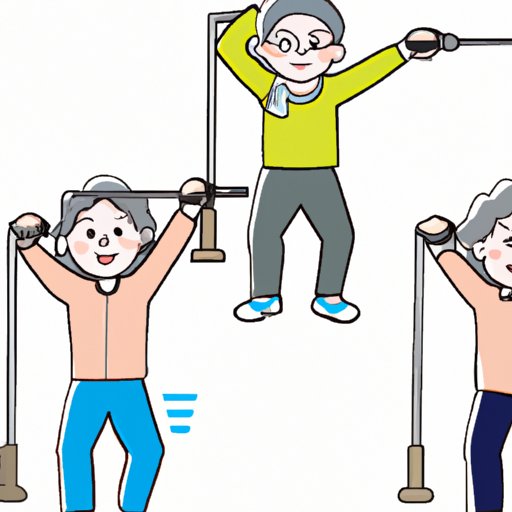Introduction
Resistance exercise is a type of physical activity that involves working against some form of resistance, such as weights or bodyweight, in order to strengthen and tone muscles. It has become increasingly popular in recent years due to its numerous benefits for both general health and specific goals, such as weight loss or injury prevention. This article will provide a comprehensive guide to resistance exercise, including what it is, how to do it, and the different types of exercises. It will also discuss the benefits of resistance exercise and provide tips for beginners, as well as advice on how to use resistance exercise for specific goals, such as weight loss and injury prevention.
Explainer on Resistance Exercise
Resistance exercise is any form of exercise that involves working against resistance in order to strengthen and tone muscles. This resistance can come in the form of weights, bands, machines, or even just bodyweight. The goal of resistance exercise is to increase muscle strength and size, as well as improve muscular endurance and tone.
Resistance exercise can be done in a variety of ways, depending on the individual’s goals and needs. For example, someone looking to build muscle mass may opt for heavier weights and fewer repetitions, while someone looking to improve their muscular endurance may opt for lighter weights and more reps. Additionally, there are many different types of resistance exercises, such as free weights, machines, and bodyweight exercises.
A Beginner’s Guide to Resistance Exercise
Getting started with resistance exercise can seem intimidating, but it doesn’t have to be. Before beginning any new exercise program, it’s important to understand proper form and technique in order to prevent injuries and maximize results. It’s also important to start slow and gradually increase intensity as you become more comfortable with the movements. Below are some tips for getting started with resistance exercise.
- Start with bodyweight exercises before adding weights.
- Focus on proper form and technique.
- Start with lighter weights and higher reps.
- Gradually increase weight and decrease reps as you become more comfortable.
Benefits of Resistance Exercise
In addition to building strength and improving muscular endurance, there are many other benefits associated with resistance exercise. According to a study published in the journal Frontiers in Physiology, resistance training has been linked to improved cardiovascular health, increased bone mineral density, better balance, and improved mental health.
Furthermore, resistance exercise can have a positive effect on overall health. Research shows that regular resistance exercise can help reduce blood pressure and cholesterol levels, improve insulin sensitivity, and reduce the risk of developing chronic diseases such as heart disease and Type 2 diabetes.
Lastly, resistance exercise can have a positive effect on well-being, as it has been linked to improved mood, reduced stress, and improved sleep quality.

Resistance Training for Weight Loss
In addition to its numerous health benefits, resistance exercise can also be a great tool for weight loss. Studies show that resistance exercise can help boost metabolism, burn calories, and build lean muscle mass, all of which can aid in weight loss. Furthermore, resistance exercise can help maintain muscle mass during weight loss, which is important for reducing the risk of regaining weight once the diet is over.
To maximize weight loss through resistance exercise, it’s important to focus on compound exercises that work multiple muscle groups at once. Additionally, it’s important to keep up with a consistent routine and challenge yourself by increasing weight or reps as you become stronger.
Resistance Exercise for Injury Prevention
Resistance exercise can also be used to help prevent injuries. By strengthening and toning muscles, resistance exercise can help protect joints from injury, especially in athletes. Additionally, research shows that resistance exercise can help improve coordination and balance, which can also help reduce the risk of injury.
To minimize injury risk during resistance exercise, it’s important to focus on proper form and technique. Additionally, it’s important to start slow and gradually increase intensity as you become more comfortable with the movements. Lastly, it’s important to warm up and cool down properly before and after each workout.

Resistance Exercise for Older Adults
Resistance exercise can also be an effective tool for older adults. As we age, our muscles naturally lose strength and tone, which can lead to an increased risk of falls and other injuries. However, research shows that resistance exercise can help improve muscle strength and balance in older adults, thus reducing the risk of falls and other injuries.
For older adults who are new to resistance exercise, it’s important to start slow and focus on proper form and technique. Additionally, it’s important to consult with a doctor before beginning any new exercise program. Lastly, it’s important to find an appropriate level of intensity that is challenging but not too difficult.
Conclusion
Resistance exercise is a great tool for improving strength, health, and well-being. It can also help with weight loss and injury prevention, as well as provide specific benefits for older adults. This article has provided a comprehensive guide to resistance exercise, including what it is, how to do it, and the different types of exercises. It has also discussed the benefits of resistance exercise and provided tips for beginners, as well as advice on how to use resistance exercise for specific goals, such as weight loss and injury prevention.
(Note: Is this article not meeting your expectations? Do you have knowledge or insights to share? Unlock new opportunities and expand your reach by joining our authors team. Click Registration to join us and share your expertise with our readers.)
